The term “horse power”, was invented by James WATT in the early 1800’s, when he was working on improving the performance of steam engines.
He made his calculations based on the work output of pit ponies and now the term “HP” is used on anything that has an engine including your house and garden gadgets.
Steam (railway) engines were used by the Police of Dorset from the beginning in 1856 to get around the County of Dorset, mainly when transporting prisoners in the 20th century, but we will start at the beginning like all good stories with the horse.
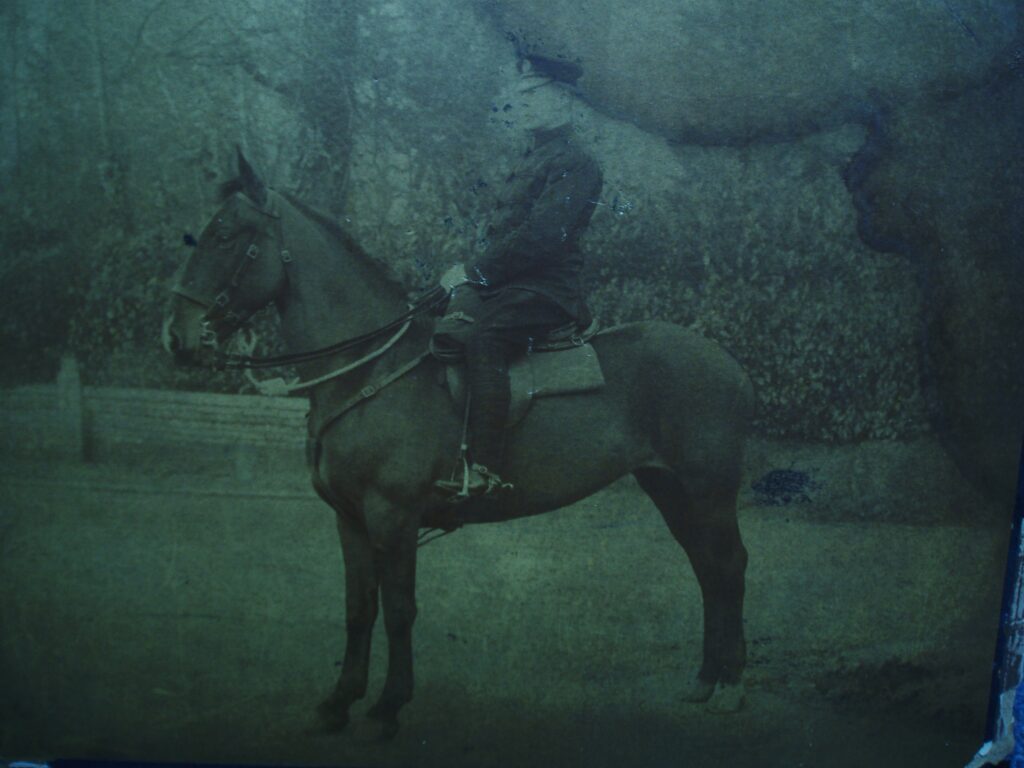
In 1857 the original nine Superintendents of each division were authorised to purchase a horse. They would have be provided with a cart, built by R BALL of Shaftesbury who won the contract, along with Philip BISHOP of Bere Regis who supplied the harnesses. BALL not only made and supplied the carts but also secured a contract to keep them in good repair for five years. The above photograph is one of the earliest horse photographs, but the unknown Supt has a flat cap, which tells us it was taken after 1902 and in that era, so no where near the early horses ! Basically there were very few photyogrpahs in the 1800’s.
Policemen in those days walked for miles during their daily tours of duty and to supervise them the Superintendents needed to get around their division by either riding the horse or using the cart. The horses also needed stabling and needed to be looked after so a stable was built within the yards of each station and one of the police constables was delegated to feed and look after it. It was not long after the term “reserve man” was being used for this police constable, as his chores with the horse and upkeep of the station started to mount up. He would still do night duties when required too, but mostly worked along with his Supt at daytime.
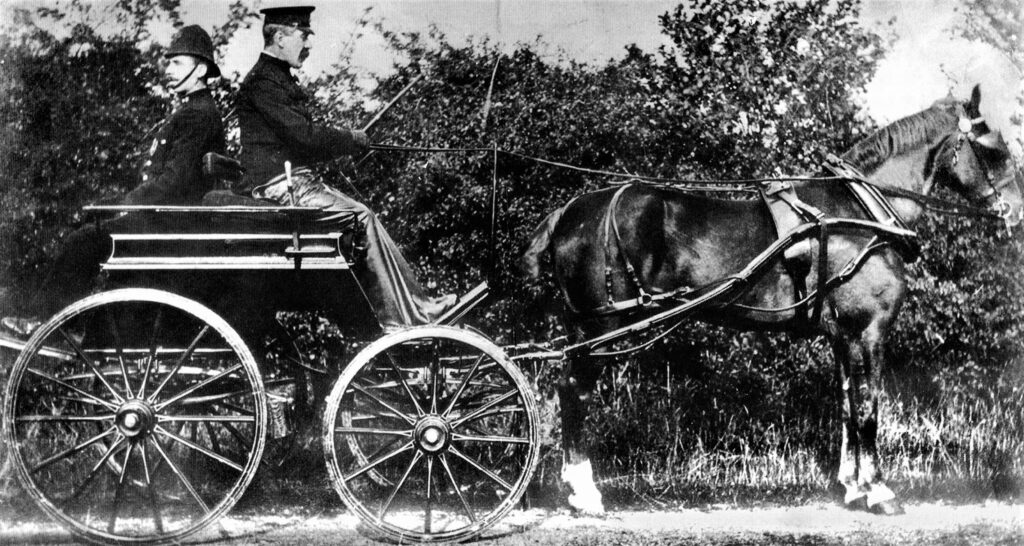
A reserve man with his Supt, horse and cart but date and location not known.

In this photograph from between 1905 and October 1910, you can see who the reserve man is, as he is next to the Supt. Whenever the horse and cart was required the reserve man would need to be there to be be left in charge whilst his Supt dealt with other matters and meetings. Whenever the horse was too old or not up to the job then it would be sold on and replaced, just like the cart and this carried on for the nearly seventy years.
In 1894, Wiltshire police were using bicycles and as a result the Dorset Police Standing Joint Committee ( SJC ) approved, that the Chief Constable purchase one in late October for the Dorchester Division. In November, a request was circulated that all officers that could ride a bike were to let HQ know. The first bicycle, which had solid rubber tyres was purchased for 8 pounds and 10 shillings. This investment proved to be a big success and the following year the Chief Constable wanted many more as they were saving time and proved very useful in tracking down offenders. The Chief wanted 6 more bicycles, one for each division like other County Forces. He stated that about half of his men were now able to ride a bike.
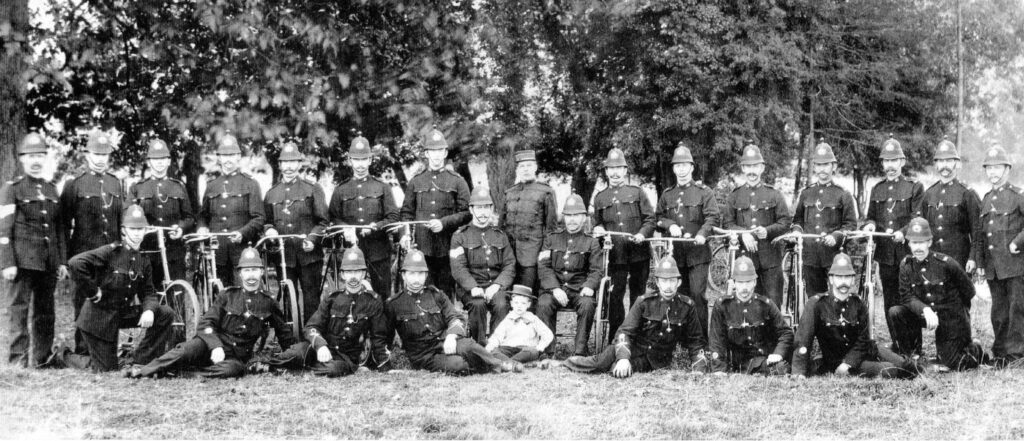
The photograph above is pinched from Melvin HANN’s Bobbies on the Beat book with his permission. It says the photograph of the Poole Division officers was in 1894, but it must be later.
Dorset Force Orders 15th May 1895, Bicycles and Tricycles:
The above to have been declared to be carriages within the meaning of the Highways Acts with the additional regulations: 1st, that during the period between one hour after sunset and one hour before sunrise, every person riding such carriage shall carry attached to the carriage a lamp which is to be kept lighted. 2nd, upon overtaking any cart or carriage, horse or other beast of burden or any foot passenger, every such person shall within a reasonable distance, from and before passing, sound a whistle or bell or give other audible and sufficient warning of their approach. Officers will pay particular attention to this matter, and if necessary, they will patrol in plain clothes to put a stop to this dangerous practice.
Dorset Force Orders 10th Sept 1895
Whenever Supt’s send constables on duty on a bicycle, he must satisfy himself that the man is sufficiently a good rider to avoid the machine getting beyond his control. This memorandum is issued after a recent accident. (No details of whom was involved).
Two years after the initial experiment had proved successful, the Force owned 10 bikes and 41 had been bought by Sgts and Constables. Six of those bikes had “cushioned tyres” which I can only presume means they were not solid. The police committee mooted that all Constables and Sgts should be using them to help keep down crime figures and should be subsidised. Another incentive was that they were now being used at the police athletics meetings and prizes could be won. This photograph shows officers from all around the County and their own bikes, gathered at Poole in 1898.
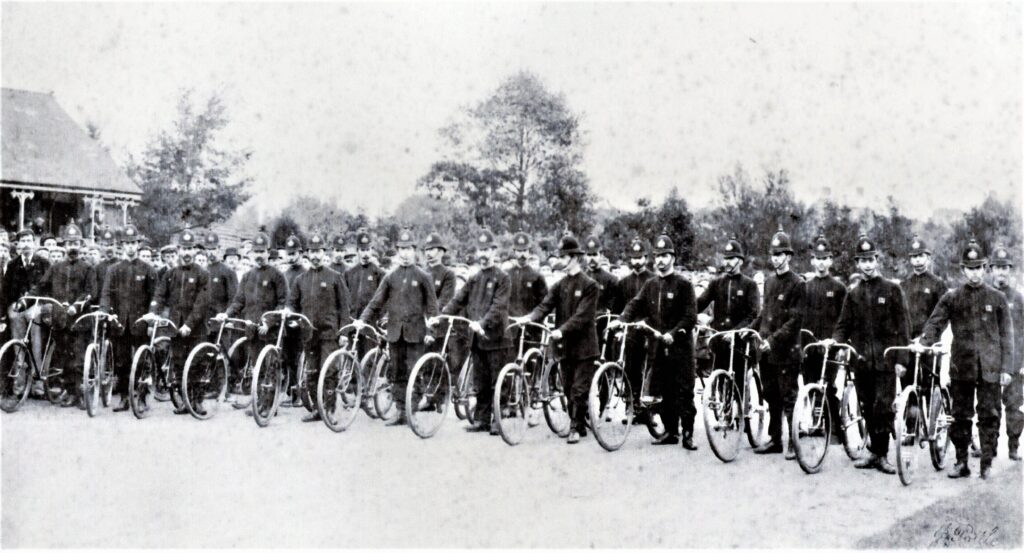
This exert from Vic SWATRIDGE’s memoirs should give you a taste of how transport helped a policeman’s life, although it was by no means easy.
“My father was told in 1898 that next he was to be the local policeman at Chickerell and in doing so was moving half way across the county from his current station, Bourne Valley. This was not an easy task, to transport household furniture in those days. Removal vans were few and far between and only then used by the more affluent people and a policeman had to find his own means of transport and was given an allowance by the police authority (SJC) of so much a mile and a small house refitting allowance. This was looked upon by the policeman as a chance to save or make some money, maybe a few shillings that would enable my mother to buy some new linoleum and curtains or at least contribute towards them.
The mode of transport in this instance was an open two horse wagon, on to which was loaded all the family’s furniture and all the pots and pans. There was no problem getting it all on, as homes were very sparsely filled and the family had to make do with what little they had. This was three years before I was born, but the journey and its problems were related to me as a boy and it was imprinted on my brain and never forgotten.
My father left Langley Road police cottage at Bourne Valley, where my two eldest brothers Arthur and Cecil were born, and at 10 o’ clock at night with a driver he travelled at walking pace, throughout the night and on one or two occasions had to hire a trace horse to help pull the loaded wagon up the steeper hills and believe me roads were roughly surfaced, way before smooth tar macadam was used. The roads were very narrow with high hedges boarding the sides and often with deep ruts which made the trip very unpleasant.
My father did not arrive at the house until midday the following day 14 hours later. My mother and two very young brothers stayed that night at a neighbour’s house and then travelled by train to Weymouth. At Weymouth my mother then had to walk three miles whilst pushing the two boys in a pram. Then they had very little time to put the house together before my father was on duty again the same day.
Chickerell was part of the Dorchester division, way before Weymouth Borough police amalgamated, and it was a time when Portland was becoming very busy with the final stages of the breakwater being built. Most of the labour came from the convicts on the island, but there was also a very large force of Irish navvies assisting them. Ireland at the time had very little industry just agricultural jobs so its lack of wealth meant much of its population was taking its chance in England as it was better than starving back home. The navvies were nearly all habitual drinkers or drunks and the public house were the greatest attraction to them especially as they stayed open for virtually 24 hours and rarely closed except after midnight till 0600 hrs in the morning.
My father, was often ordered to attend Portland for evening duty at the Top Hill police station to help control the navvies who were causing annoyance to the local inhabitants. Walking that distance of nearly 6 miles was a time consuming chore and he decided to buy one of the first bicycles with pneumatic tyres rather than the solid ones he had previously used. The tyres could be inflated, but it took on occasions about an hour to inflate them, which meant at times he decided not to bother and just walked home at 0100 hrs when given permission to stand down by the time all the fighting had stopped by the island Sgt.
My father said that this distance was minimal compared with the PC at Puncknowle who used to walk in the evening to Dorchester, a distance of about 18 miles just to attend a St John’s Ambulance lecture”.

By the 20th century the Chief Constable reported that the 6 cushioned tyre bikes they owned were worn out and that they should rethink granting the bicycle subsidy, as the 38 Sgts and Constables needed to have their bikes which were still a great help in arresting offenders and for general police work, even though the age of the motor car was dawning.
In early 1902, the ex railway station master Mr POTTER complained that he had nearly been knocked over by a Constable on a bike who was cycling on the wrong side of the road at Poole, although no names were mentioned.
By 1903 the motor car was being seen all over the country including Dorset and upsetting quite a few of the local magistrates especially concerning excessive speed through towns and villages. As a result, the Government introduced the Motor Car Act. It was not complex, but brought in the offence of “reckless driving “, and the speed limit was raised to 20 mph from 14 mph which had been in force since 1896. All cars were also now to have vehicle registration plates displayed. Drivers now had too obtain a driving licence and they had to be at least 17 years old for cars and 14 years old for motor cycles. The cost was 5 shillings, but there was still no sign of a driving test being introduced.

In 1914 the Force hired its first motorised transport at HQ as at the outbreak of war many of the fit horses were requisitioned for the war effort. The motorcycle and sidecar, was for the use of the Dorchester Superintendent and the following year, three Douglas 22hp motorcycles were purchased for the superintendents of Portland, Sturminster Newton and Wareham. The photograph above shows some similar motorbikes from the era.
In 1919 it was thought that motor cars replaced all the horses at stations except Sherborne where the last horse remained for the next three years, however it was not that simple, when times were hard just after WW1. In October it was reported to the Police Committee, that the Force had at the time 7 carts and horses and 8 motor bicycles for the Divisional Supts and a motor bicycle with side car at HQ for use by the DCC. The Chief Constable said that these modes of transport were not adequate for his Supt’s daily work. He went on to say that it was a time when horses were difficult to get hold of and expensive due to demand to buy and feed. It was now the right time to purchase cars which would also mean the reserve man would be freed up to be a police man again. He said that the Force should keep 3 motor bicycles, one at Poole as Supt WHITE could not get to his all his men by tram, the other 2 were for Sherborne and Sturminster Newton.
Ideally, he wanted to purchase Fords that had four seats for the Supt’s at Blandford, Bridport, Dorchester, Portland, Shaftesbury, Wareham, and Wimborne. The DCC required a small car which could be used for patrol if one of the other cars broke down. There was much debate about the expense and the Chairman, Colonel COLFOX was not happy that the Chief wanted to buy American cars. The rest of the committee were also not impressed that the tax payers of Dorset would again be forking out for cars when they thought the motor cycles were perfectly adequate. At the end of the debate it was decided it would be looked into by a Sub Committee and reviewed in another twelve month’s time.
In 1920 the next traffic act was brought in, which introduced a tax on each vehicle called the Road Fund. This was the start of the Vehicle Excise Licence and brought in, so motorists paid for the building of roads and their upkeep. It also stated that the Road Fund Licence had to be displayed on the vehicle.
Again from my grandfather’s memoirs.
“Supt Arthur SWATRIDGE, my father, retired from the police force at Sherborne on 3rd October 1920, as a 2nd class Supt and after completing nearly 29 years of service, so he received a pension of 6 pounds a week. With my eldest brother, who also wanted an outside life, he rented 60 acres of land and a farm at Bembury, Thornford. This land was very poor and comprised of 50 acres of arable and 10 acres of grass land. The last police horse at Sherborne was called Tom, who my father purchased for the job of ploughing the land. Tom was very reliable but now a good age and the police had little use for him. With my eldest brother and parents, I was also involved in the ploughing on the land with Tom and another horse. I wanted to join the police but it was a time when the Force was not recruiting after so many officers had been taken on after WW1. I would have to wait for 3 years and have to work on the farm till my chance came”.
During October 1920 the topic of cars, was again discussed and the Sub Committee. They said it was now time to provide cars for Blandford, Sherborne, Beaminster and Dorchester. Again, there was a heated discussion where it was pointed out that horses were cheaper due to a larger supply and that the motor bikes were adequate unless the Supts were too old and unfit to ride them, then a side car could be added.
At that time there were police motor cycles at Dorchester, HQ, Wimborne, Shaftesbury and Sturminster Newton. Once more it was decided cars were not required yet and should be looked into again the following year. So it looks like ” Tom ” the horse, may have been bought later than October 1920 and it is probably him below !

In May 1921, the Chief Constable again put more pressure on his Committee by stating that as soon as the Weymouth Supt was in house he would getting rid of the horse and wanted him to have a motor vehicle. This would mean the reserve man could be used as an extra man to police Portland. The Wareham horse was also old and unfit for use so was being dispensed of. He was going to try an experiment to see if the Supt there could use the train and hire a car when needed. This was provisionally agreed too, to see what the outcome was.
After the war some horses were acquired from the Army as not required anymore and in November 1921 the Dorchester division horse was also unfit so was returned to the military authorities and again the Chief Constable was given permission for the local Supt to hire a car as the experiment at Weymouth and Wareham had proved to be a success.
In July 1922, Supt Alfred BARRETT was sick of getting wet on his carriage and bought his own car. He then asked the Committee if he could use the car for police work and get an annual allowance. This was sanctioned and a figure of 65 pounds was agreed to, which would pay for insurance, petrol and servicing. Later that year it was decided that motor cycles should also be provided at HQ and Shaftesbury due to the amount of travelling involved.
In 1923, Supt BARRETT was moved to Dorchester and carried on his agreement at his new station and Supt William WHITE took over at Sherborne. Supt WHITE who had just been promoted also bought his own car and was given the same allowance . At Wimborne, Supt Ernie THOMAS’s motor cycle was worn out so he also bought his own car and got the same allowance. A few months later Supt Harry LAWRENCE at Blandford did the same and Supt Bertie SPRACKLING was still claiming the same allowance at Wareham in 1925.
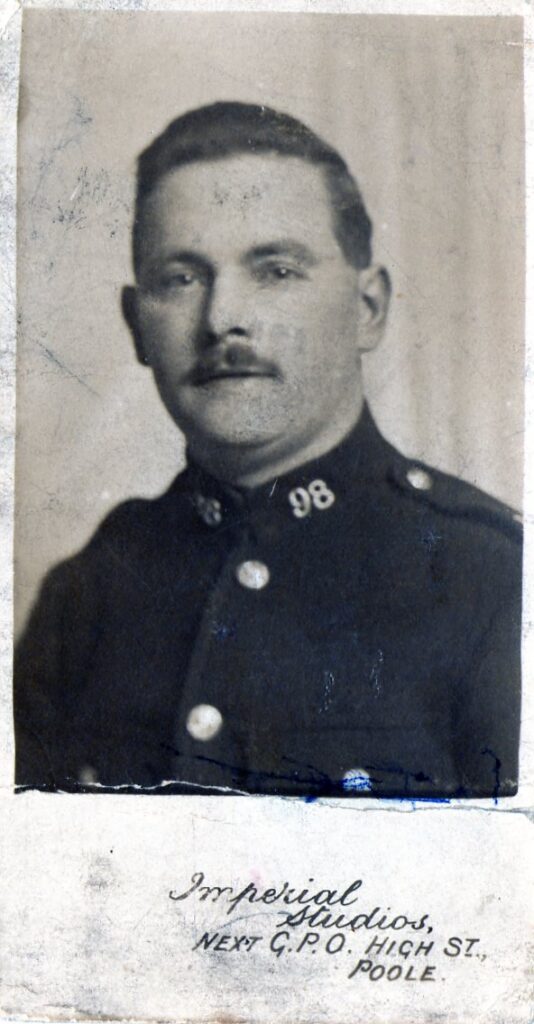
There were now a great deal of motor cycles on the road and the policemen all over the County were buying them for their personal use. There were several accidents off duty including, my great uncle, PC 98 Cecil SWATRIDGE who, on the 1st September 1923 came off his motorbike in Bournemouth and sustained a broken leg. This was a “bone” of contention for the Force as initially he was given 3 months sick leave which then continued to 6 and then 9 months before he was fit enough to return to duty. At this time road accidents had increased dramatically as in1909 records show that, there were 12,000 accidents and 400 fatalities in the Country which rose by 1924 to 67,000 accidents and 3,000 fatalities. WOW !
Up until 1924 Dorset had kept its used carts and harnesses in case still required, but with no horses left it was decided that the items cart and horse related items should be auctioned off. Pedal cycles were still being used by the village policemen, who had always got an allowance to keep their bikes in good order for obvious reasons.
In November 1925, PC CROSS who was stationed at Portisham was travelling on the main road to Abbotsbury during the hours of darkness. He had a light on his bike to see ahead and he was carrying his cape over his shoulder. It was very windy and was riding along he was trying to adjust his cape to stop it blowing off when he collided with something. When he turned round he realised he has hit a local woman who he knew called Ethel Maude HAYNE. The woman did not appear to be badly injured but three days later she died from internal injuries and her father made a claim against the Force. At the inquest it was decided it was an accident and no blame was to be attributed to PC CROSS. It was decided that it was death by misadventure. As a good will gesture the family were offered a gratuity of 50 pounds which they accepted.
In 1926, Supt William WHITE was moved from Sherborne to Poole and newly promoted Supt, Samuel LOVELL replaced him. By now it was a routine for the Supt to apply for the same allowance for his own car so he could supervise his men from Sherborne and Shaftesbury which was now a Sub Division with an inspector. In 1927 some officers were allowed to use their own motor cycles as long as they were insured for police work.
In August 1928, PC 183 Jack CLIST who was stationed at Bourne Valley was out riding his own motor bicycle in the evening around Branksome when off duty, he collided with a car which resulted in several injuries including a broken collar bone.He was taken away by ambulance to the Royal Victoria hospital at Boscombe.
In October 1929, PC Reginald GENTLE was up in court at Beaminster, for a complaint that on 26th September he was driving his motor cycle in a manner dangerous to the public. At the time he was travelling along the west road at Bridport and had a sidecar attached. The sun was low and he collided from behind, with two girls who were walking along the road. There were no serious injuries and he claimed his vision was impaired by the sun, but was still fined 2 pounds as he was adjudged at fault.
The following year, on July 24th, PC 215 Wilfred VINEY and PC 99 Frank BISHOP were on plain clothes patrol in the Preston area near Weymouth. They were on a police motorcycle near Chalbury Lodge, when witnesses in the area heard a large bang and afterwards found both officers lying in the middle of the road.
Both officers were still alive when the first witness found the scene and the motorcycle was found to be badly damaged next to them. PC VINEY sustained severe head injuries and a fractured leg and died at the scene where as PC BISHOP had lesser injuries to his head and hands. There was evidence at the scene that the motorbike had hit a stone wall and it was believed that PC VINEY was the pillion passenger. PC BISHOP was taken off to hospital where he recovered and when interviewed explained that at the time of the accident PC VINEY had been driving the bike although it was BISHOP’s bike. He stated just prior to the accident VINEY accelerated towards the wall and he believed that he had mistaken the wall as the direction of the road as the lighting at the corner was poor on the night. Wilfred VINEY was 30 years old and had served for 9 years and 113 days, he left a wife and a 3 year old child.
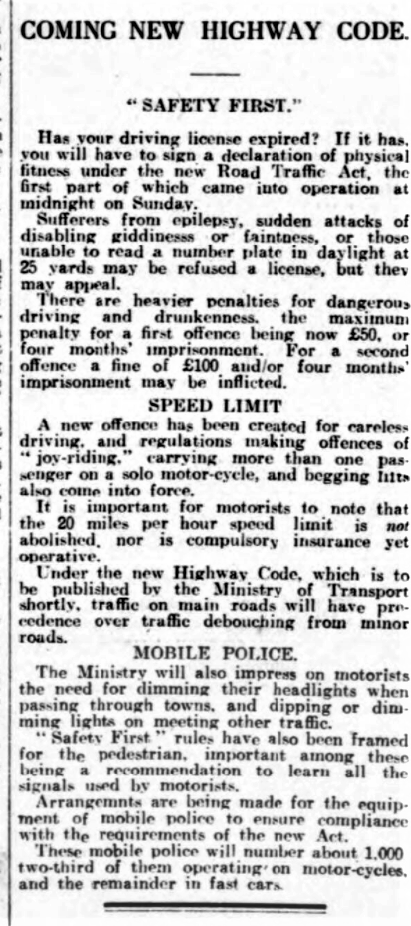
In late 1930 the first Road Traffic Act was introduced and the local papers reported it, just like everything else. The Act led to the first discussion of the police committee of what was required for the County. The act came into effect on 1st December and firstly abolished the 20 mph speed limit, although buses and coaches were regulated by a 30 mph limit. Further offences came in, which were dangerous, reckless and careless driving and driving whilst being unfit through drink or drugs. 3rd party insurance was now compulsory and a driving test had to be taken by anyone who was disabled. The Chief Constable told his Committee that they now had the powers to crack down on the numerous motorists offences and he was going to make sure that Dorset complied with the Government recommendations of enforcing the laws.
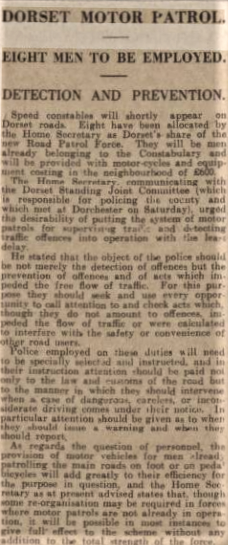
The above article from the Western Gazette was published on the 13th Feb 1931 and as a result here is really the first Traffic Department with the 8 motor cyclists. The recruited Constables with their 8 Norton 498 hp ohv motorcycles and appropriate clothing. Note they do not have helmets, just a good hat and goggles, plus heavy duty gloves and a leather satchel.
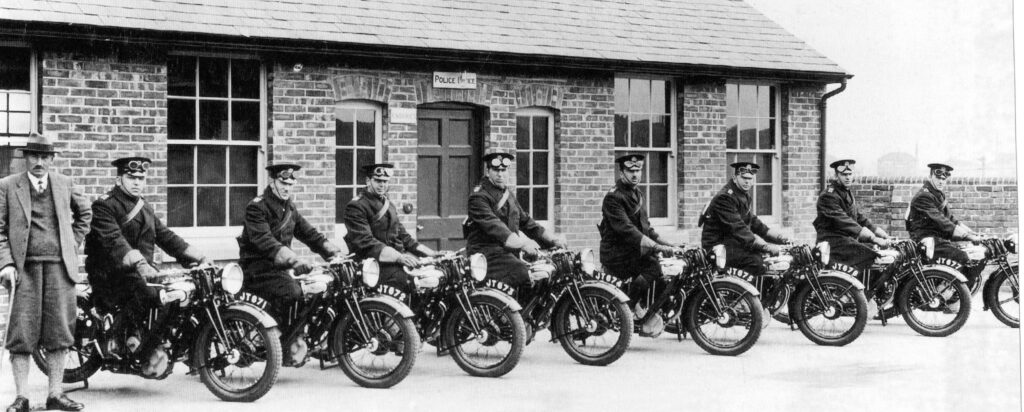
The photo shows from left to right
The Chief Constable, Mr Peel Yates being flanked by:
1: PC 99 Francis G BISHOP, Blandford Division on JT871
2: PC 148 Frank E PAYNE, Bridport Division on JT872
3: PC 131 Tom A CONWAY, Dorchester Division on JT873
4: PC 77 Albert W MARSH, Poole Division on JT874
5: PC 114 John CULLEY , Sherborne Division on JT875
6: PC 23 Arthur J STICKLEY, Wareham Division on JT876
7: PC 112 George WARD, Weymouth Division on JT877
8: PC 44 John WITT , Wimborne Division on JT878
Slightly enlarged versions to highlight the photograph.


Again from my grandfather’s memoirs:
“In the mid 1930’s when I was the Admin Clerk at Sherborne, It was the practise when the Superintendent was on holiday or away from the division on special duty, which was very rare, that the Inspector at Shaftesbury (Shaston) had to visit Sherborne to make sure all was in order. The only car for police purposes at the time was the Supt’s who had a fairly liberal allowance granted annually, although he had to keep it well serviced and good condition even though it was his own car. On the other hand ,the Inspector in the Sub Division had the use of the police owned motor cycle, which was 2 and a half power belt driven Douglas machine. Insp George CHURCHILL was an extremely nervous rider and without a kick start he had to be pushed off. Now this was extremely tricky procedure for the location and the fact that the Inspector was 50 years plus. The old Sherborne police station had a short sharp slope under the entrance into the court yard which was paved with cobbled stones. There were heavy double doors at the entrance about 10 feet high and cumbersome to operate and of course securely closed when prisoners were in the cells. The doors were always left discretely left open for the Inspector until his arrival and shut afterwards. When Insp CHURCHILL was kitted up in waterproof clothing and leggings ready to return to Shaftesbury, the station reserve man which was Tom ELLERY would open both doors and stand at the top of the incline in Digby Road to make sure nothing was coming for an unhindered departure. PC ELLERY would look out at the road and signal to the Insp to get mounted, start his machine and away he went precariously. Of course being younger we used to snigger about the manoeuvre and my word, what a calamity if the engine stalled. If that happened it was, start all over again.
George CHURCHILL was far more comfortable with a horse and trap”. George below in his younger days !

In early 1935 the Home Office sanctioned that the Force could employ another three officers so that they could deal specifically with vehicles breaking the speed limits. The Police Committee recommended that four cars be purchased and four constables be used as there was a grant from the Road Fund towards the cost of running the cars. The proposed car should be of 10hp and the cost should not exceed 180 pounds each. There were five motorcycles at the stations which could be disposed of as part exchange except for the motorbike at Poole which could still be used for general purposes. The Committee discussed all the issues and they decided to oppose the increase of three officers as the County could not afford to spend more on officer’s pensions. The Chief Constable then spoke and it was then confirmed that three already employed PC’s would suffice and three cars not four would be purchased.
The cars were purchased and registered and the below photo shows from the purchases in front of the old stables at Dorchester police HQ, again with enhanced versions.
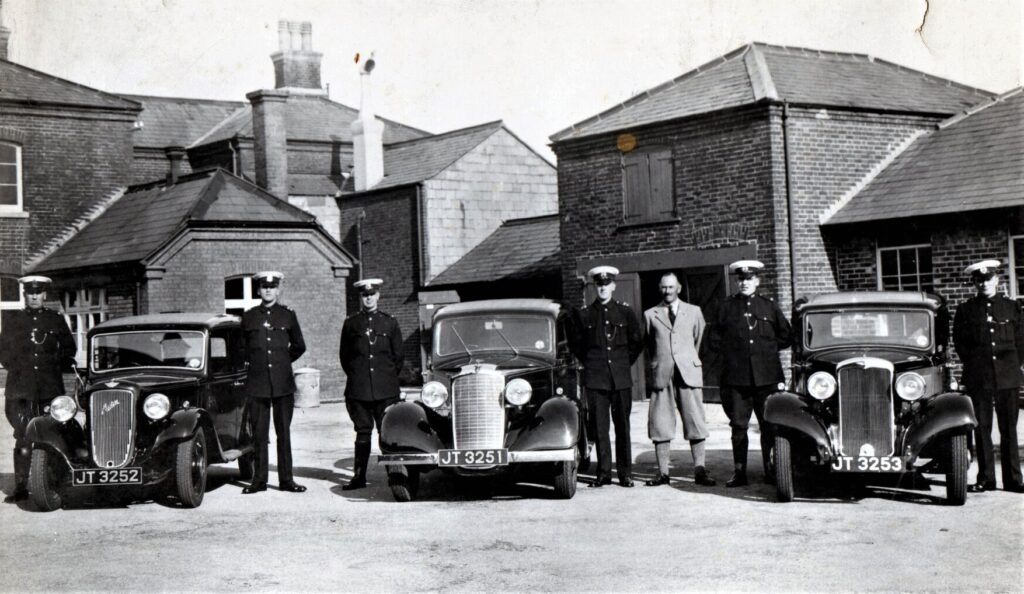
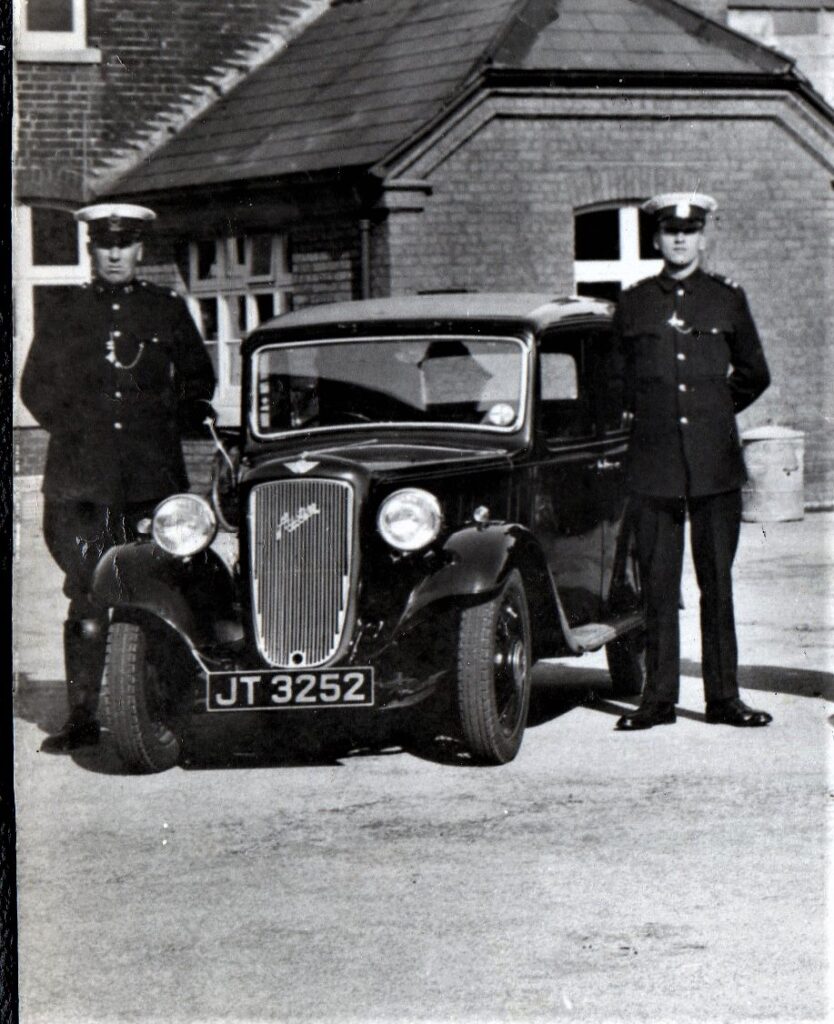
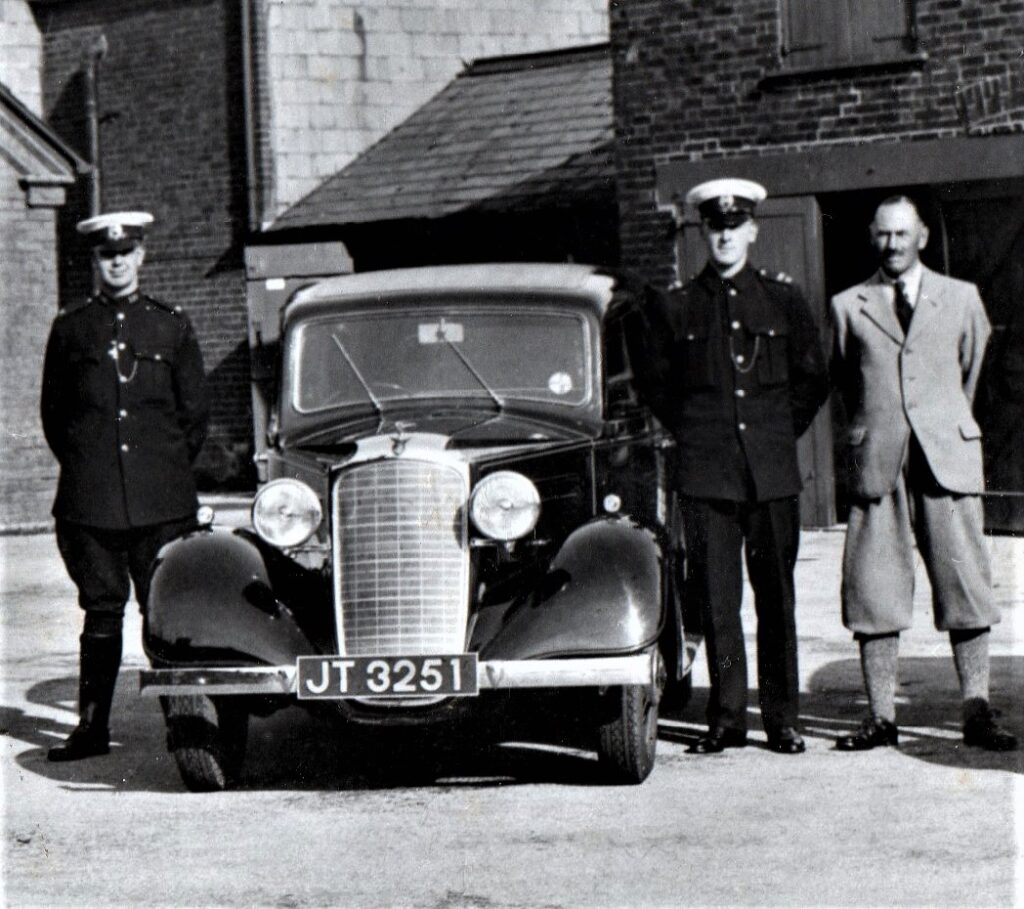

1: JT3252 which is a Hillman Minx 10hp car bought for 142 pounds. This car was used at Blandford by PC’s 77 Albert MARSH and 174 William John COWLING
2: JT3251 which was a Vauxhall 14-6 14hp bought for 187 pounds which was used at Dorchester by PC’S 131 Tom A CONWAY and 189 Gilbert John Robert HINDLEY known as Bob stood next to the Chief Constable Peel Yates.
3: JT3253 which was a Austin 10hp bought for 139 pounds and used at Poole by PC’s 99 Francis BISHOP and 193 Charles FUDGE.
JT is the area code “identifier” for Dorset and Bournemouth JT then numbers up till about 1950 until it was reversed so the max of 4 numbers came first.
If you carefully look at their trousers and foot wear PC’S MARSH, CONWAY and BISHOP are the three dedicated drivers.
Here is PC Tom CONWAY showing he is very proud of his Vauxhall car although his trousers seem to be better tailored.

The next photograph below is believed to have been taken circa 1937
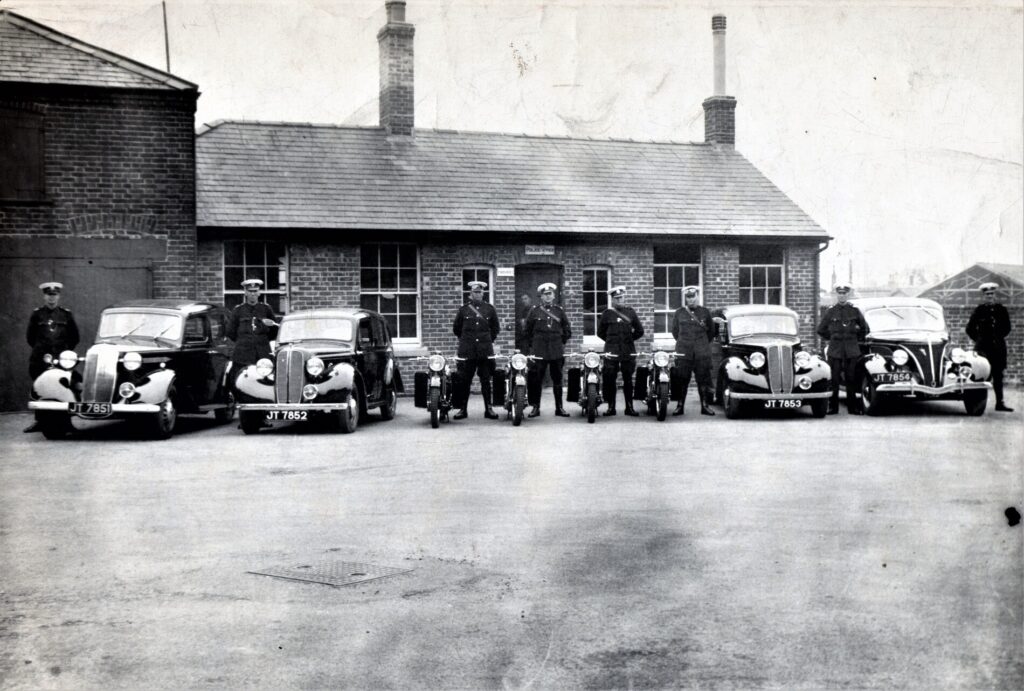
1: JT7851 thought to be an AUSTIN with PC 131 Tom CONWAY
2: JT7852 thought to be an AUSTIN with PC 77 Albert MARSH
3: MOTORCYLE with PC 23 Arthur STICKLEY
4: MOTORCYCLE with PC 76 Ronald FUDGE
5: MOTORCYCLE with PC 193 Charles FUDGE
6: MOTORCYCLE with PC 17 Jack GRAY
7: JT7853 thought to be an AUSTIN with PC Kenneth PARSONS PC 51 OR 106 ? Not sure which at this point in time.
8: JT7854, car not known but possibly with Bob HINDLEY or Frank PAYNE
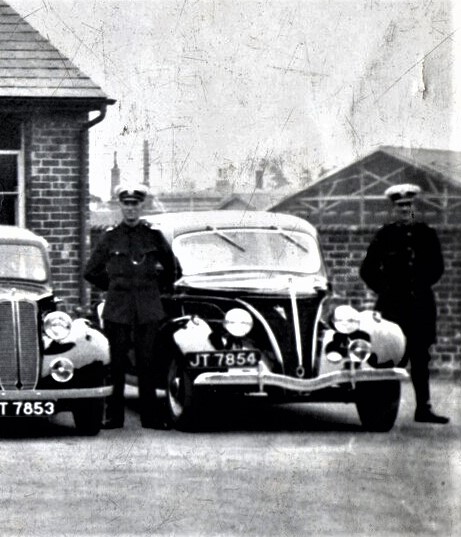
In 1938 it was decided to set up a dedicated Traffic Department at HQ Dorchester.
This was discussed in at the July meeting with the Police Committee and the C/C requested that extra police were needed to deal with the increase in offences in comparison with other Counties. He wanted to set up a dedicated Traffic Department which would need two Inspectors, one Sgt and 19 Constables and this was granted by the Committee.
In early September that year, PC Sidney LOADER who was the local bobby for Winterbourne Abbas was on patrol and had just met up with his sergeant, Harry LOVELL before continuing down Long Bredy Hut Hill on his pedal cycle. As he cycled out of the junction at the base of the hill, he turned right on to the main Bridport to Dorchester (A35) road and immediately collided with a motor car doing about 40 mph. PC LOADER was knocked off his bike. His injuries were so bad that he only survived for 24 hours before dying in hospital the following day. On Monday 12th September his body was laid to rest at Lyme Regis where a posy of 80 or more uniformed police officers attended.
PC 26 Sidney Frank LOADER had served for the Dorset Constabulary for more than 18 years and had worked at Dorchester, Lyme Regis, Moreton, Poole and Weymouth before Winterbourne Abbas.
A month later, in October a Traffic Department was set up at HQ Dorchester and SGT Percy LOVELACE was promoted to INSP and placed in charge.
PC 23 Arthur John STICKLEY was taken off motor patrols and promoted to SGT to take his place at Weymouth.
SGT Harry LOVELL was also moved to Dorchester and would now be SGT on Traffic with PC 131 Tom CONWAY being promoted to SGT and took his place at Maiden Newton.
PC 203 William LANNING would also join the Traffic Department after serving at Weymouth, so replacing Arthur STICKLEY.
These Constables, PC WILLIS was moved to Wareham and PC CARTER to Weymouth , but unsure if they are motorbike patrolmen !
In mid October 1938, around the same time, on a very wet morning at Lytchett Minster, PC Alfred HEAD who was 46 years old was out on patrol on his pedal cycle. He was struggling against the wind and rain according to a witness and was following a timber lorry where the planks were overhanging the rear.
At some point he collided with it and he was found on the side of the road and still conscious and breathing although died the following day in hospital.
PC 208 Alfred Ernest HEAD had served for over 25 years and was due to retirement within a year. He has started his police career by joining the Weymouth Borough Force in 1913 which then 8 years later amalgamated with Dorset Constabulary. He had served in the Wareham division for the last four years but he returned to Weymouth for his funeral which took place on the 22nd October where over 90 uniformed police officers saw him off.
In December 1938 at Poole magistrates, PC Stanley MARSH gave evidence in a prosecution against a driver that failed to stop. Just after midnight on 8th March 1938 he had been on foot patrol on Poole high street when he noticed a car driving at low speed and in a low gear with its horn continually sounding. He tried to stop the car by putting up his arm and flashing his torch but it failed to top so he ran after it and jumped on the offside barge board. Whilst trying to communicate through the driver’s window he fell off and damaged his right knee and elbow which meant he was still unable to return to work.
The magistrates decided to fine the driver 10 shillings for no driving licence and 2 shillings for failing to stop. On the 9th February 1938 PC MARSH died from his injuries after his health had deteriorated and whilst convalescing in a hospital in Fulham Road, London. PC 125 Stanley Ivor MARSH joined Dorset Constabulary in October 1934 and had served at Dorchester, Swanage and Poole where his elder brother Albert was also on motor patrols. He returned to his birth place of Symondbury where his funeral was held on 13th February 1939 and as normal there was a large contingent of uniform policemen and colleagues to see him off.
More information is in my post, ” The good, the Bad and the Unfortunate”
Two years later in July 1940, it was recommended that cars were required for rural Sgts and the C/C recommended the Sgt’s at Wool, Gillingham, Sturminster Newton, Broadwey and Broadstone needed them. The Committee approved the purchase of five new cars.
In May 1941 PC K PARSONS on Motor patrols moved from Blandford to Poole
PC William COWLING left motor patrols to go to St/newton from Poole and PC 24 A E STURGESS on motor patrols moved to Blandford. PC CULLEY is the PC at Ferndown and moved to Cranborne so must have left m/patrols years before.
In June 1942 SGT Arthur STICKLEY is mentioned in the papers as ” a PC for years on motor patrols at Wareham
In Nov 1946 C/Insp Reg SPILLER REG is promoted from Insp at Shaftesbury to then be head of Traffic., he took over from Percy LOVELACE who was promoted to Supt at Sherborne. At LOVELACE’s funeral in 1948 the papers stated that he was head of Traffic till 2 yrs ago and during war. The officers carrying his coffin were from Sherborne and Traffic.
PCs LEGG, AMOR, WHITE, DUNFORD, TRICKEY and MANLEY. I believe the last three were on Traffic.
In Aug 1948 Insp Reg STICKLEY was promoted to Insp and moved to Traffic Dept, PC Ernest RUSHEN was promoted to SGT and moved from Blandford. He would remain as the Traffic SGT till 1953.
This is an exert from Vic SWATRIDGE’s memoirs.
“My stay in the CID as an Inspector was comparatively short as on the 24th August 1949 I was promoted to Chief Inspector in charge of the Traffic Department. The Traffic department at the time had become very run down, because the Country had still not recovered from its war efforts and was terribly slow at getting into its commercial and industrial momentum. There was a desperate shortage of motor vehicles for commerce and industry which was the first priority and private cars were practically unobtainable, being strictly allocated to those authorities and organisations which applied to the National requirements. The police were somewhat favourably considered, but Dorset was a small Force and the larger Forces took priority and were more liberally supplied.
The cars under my control were not adequately maintained and had seen long service, having been put to hard usage, resulting on occasions as being unroadworthy. I was not prepared to accept such conditions for my men so I submitted strong reports to the Chief Constable on the matter. I was given authority to enquire in to the acquisition of new cars for traffic control which was highly essential, but I was not making any headway with the local dealers. The manufacturers were not cooperating with them so I decided to approach the “fountain head” by visiting the manufacturers in person in Oxford, Birmingham and others and I too experienced the greatest difficulty in getting results, although I was partially obliged with occasional supply from Wolseley. Wolseley had a good police record of vehicles, but I was far from satisfied and I switched to Fords with far better results in supply, although they were not ideal patrol vehicles. I was controlled by price and I discovered that the Fords with a flat bore engine had exceedingly good acceleration in traffic, was quick to respond but carried with it a fault which was rear wheel spin which subjected the car to skidding, it was too light at the rear. This problem was counteracted in time by weighing down the boot with heavy duty batteries.
The remarkable thing that prevailed in the early part of my stay in the Traffic Department was that second hand cars could be easily sold at extremely high prices, far and above the price of new cars and we reaped good profits when we sold old vehicles, primarily because the ordinary motorist was very restricted in supply of new cars and had to wait many months for delivery. Hence the police cars were considered to be a much better maintained and serviced rather than the ordinary run of the mill private motorists, although it was fair to say all second hand cars exceeded new car prices. Anyway I was completely successful in securing a new and efficient fleet of cars and the thing that pleased me most was initially I was challenged by my superior officer that I would not be able to achieve this result. I gladly accepted the challenge, but it meant hanging on desperately to achieve my goal”.


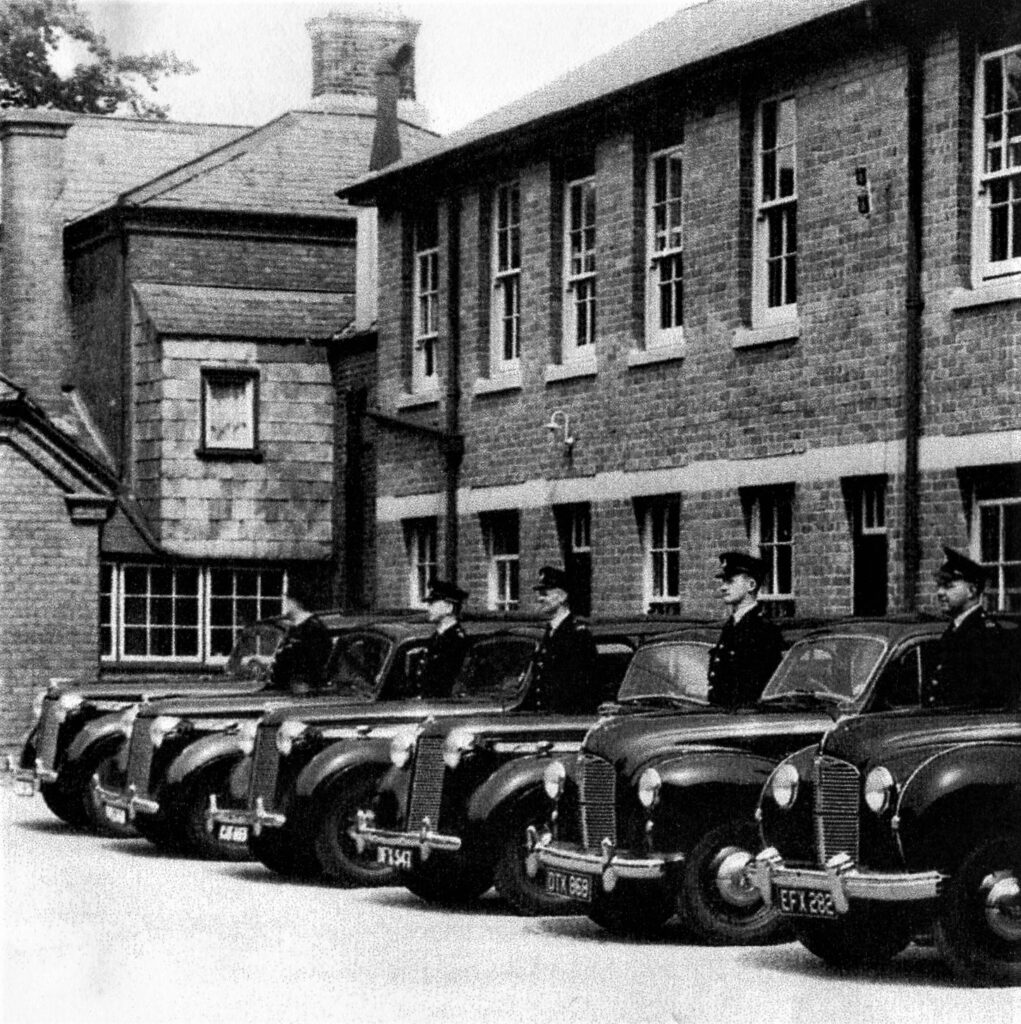
I would think this photograph was taken when Vic took over the Dept in Aug 1949, so the SGT would be Ernie RUSHEN. The Constables are not known.
In Sept 1949 PC Roy TRICKEY was promoted to SGT within the Traffic Dept, so it appears there are now two Sgts.
My grandfather continued:
“Whilst on Traffic in 1950 I also made preliminary arrangements for the Bath and West Show which was being held at Dorchester in the following summer and this necessitated a prolonged period of organisation and preparation. The site selected was on Maiden Castle Farm, west of Weymouth Avenue covering many acres adjacent to the heavy vehicular trunk road. Everything converged on Dorchester for the popular seaside resort of Weymouth and this added to the problem. It gave me great food for thought as to the most efficient way for the traffic department to direct control. It was evident that it was necessary to do so from some miles distant in a huge perimeter half moon shape, so I was desperately anxious to gain the assistance of a modified wireless control system.
The police forces of the largest cities and some large county forces had wireless control but in the south west, no 7 district, Gloucestershire was the only one with a modern set up and Devon were partially equipped. The next thing to do was to gain the interest of the Chief Constable and this was not easy to solve, mainly because of finance, but I had looked well ahead. This opportunity arose on 1st June 1950 when I accompanied the Chief to Sherborne Kings School for its 400th centenary celebration and it was honoured by the visit of King George V1 and Queen Elizabeth. It was one of the last public engagements of the king, I remember how he looked terribly worn out and distressed, having his arm in a sling, but he bravely carried on with his commitments. On the journey up from Dorchester, Sgt Roy TRICKEY was our driver (who would later also be in charge of the Traffic Department). I managed to introduce a conversation with the Chief about how useful a wireless control system would be for the Bath and West Show, stating it would be an occasion in which we could interest the Home Office and pointed out the excellent sitting of the old RAF masts at Bulbarrow. One had become redundant and was ideal for our use as I had already had a survey of the area done by a Home Office engineer from Somerset who stated it would give excellent coverage along with the mast at Eggerdon. The mast of the former was clearly visible as we travelled north and it allowed me to strongly press my point and that the show was the reason for the urgency.
The conversation was not very well received initially and somewhat rejected but I continued to press on with the subject and eventually convinced the Chief that it was an experiment worth adopting and he granted me permission to make preliminary arrangements with the Home Office and it accepted a modified wireless control system for the show. It was decided that a small substation would be installed on the show ground itself, but it was not possible to equip motor patrol cars with large sets as they were not available. Nevertheless the system could be run by including walkie talkie sets carried by individual constables covering an area of 3 miles approximately in a radius from the substation. All sorts of adaptions and difficulties arose but were surmounted as I was determined it should be a success and lead to a permanent installation of a Force wide system. The experiment was far more successful than we had anticipated, the operators of the walkie talkie sets had responded to the occasion with enthusiasm, resulting in excellent control of the traffic and the mammoth show passed without any serious mishap or accident. This fortunately for me had the effect of convincing the Chief and the Police Standing Joint Committee that permanent wireless control was essential in Dorset substations by the erection of buildings at Bullbarow and Eggardon with its control station at county Headquarters which followed in 1951. Dorset was equipped before any other Forces in No 7 district, quite an achievement for a small county Force, making it then very efficient. Our experiment at the show was closely observed by other Forces, who we then helped by supplying them information and by the staff officer at the police college, Ronald STEELE who wanted a detailed report to present a lecture at the College”.
This was the start of Dorset being ahead of other forces in all forms of communication in the traffic department and this then followed on in communications and computer technology. There is some footage of the King and Queen on You tube GB which shows all the local police stood on cheap street for the 1950 occasion.
In 1956 the Centenary Dorset Constabulary book was completed and two photographs were taken at HQ to show the fleet of cars and motor cycles the Force used.
I have copied the photograph of the motor cycle fleet from the book because Bill PEACH, the son of then PC Geoff PEACH has passed on information about the officers in the photograph.
In charge far right is Ch Insp Tom CONWAY who was in charge of the Traffic Dept from 1950 till he retired in November 1956.
On the left is Sgt Walter MANLEY, who went on to be a C/Insp.
The other officers are all PC’S and in the front row from the left are thought to be:
PC’s Sid STICKLEY, Douglas LEGG, Derrick DAVIS, Ted TOOP, Austin CRABB, SQUIBB and Charles PITT.
There are 6 constables at the rear from left to right, names are:
PC ROBERTS, 2 and 3 not identified, PC’s Cyril WEBSTER, Geoff PEACH and George FINNERTY.
Below is the photograph.
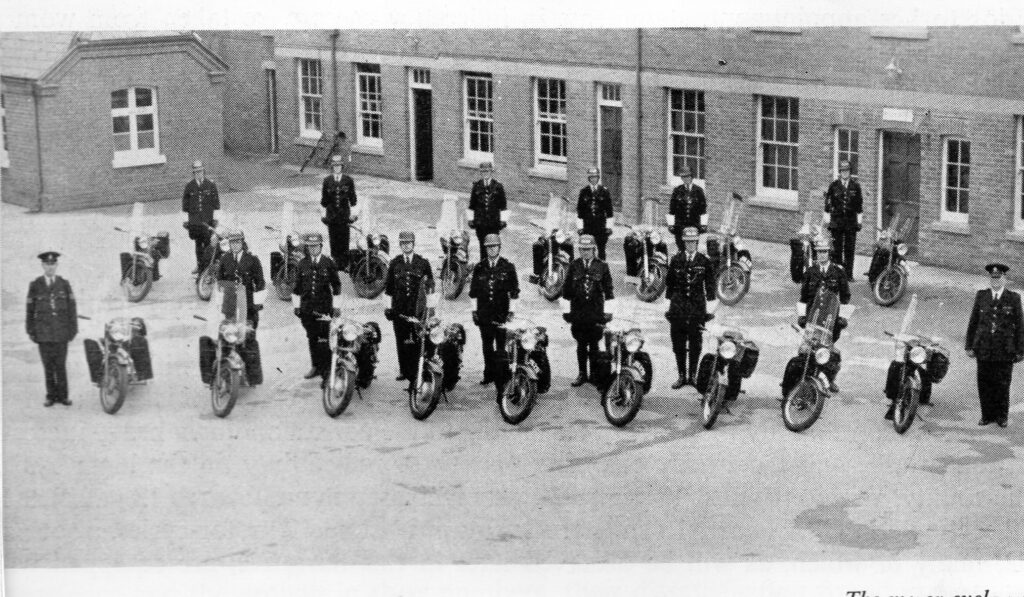
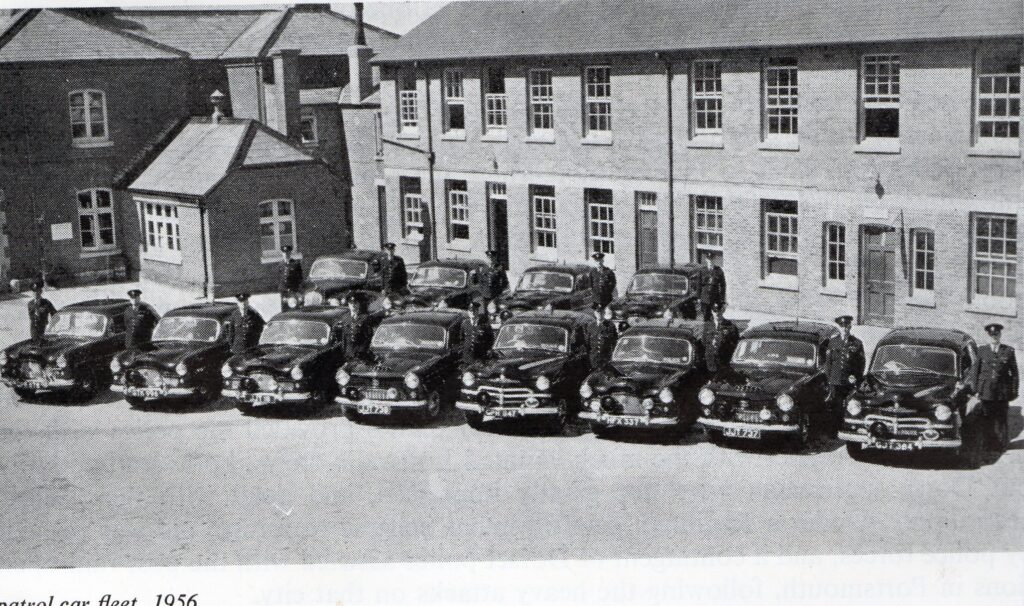
The next photograph from the Bobbies on the Beat book show the newer Excelsior Talisman motor bikes and their riders from the late 1950’s the officers are from left to right:
PC James (Jim) CULLEY who was a PC on traffic for most of his career.
PC Denslow HIGHMORE who retired as a C/Insp at Bournemouth.
PC Frank PRATT who retired as C/Supt at Bournemouth.
(Information with thanks from Hayne RUSSELL)
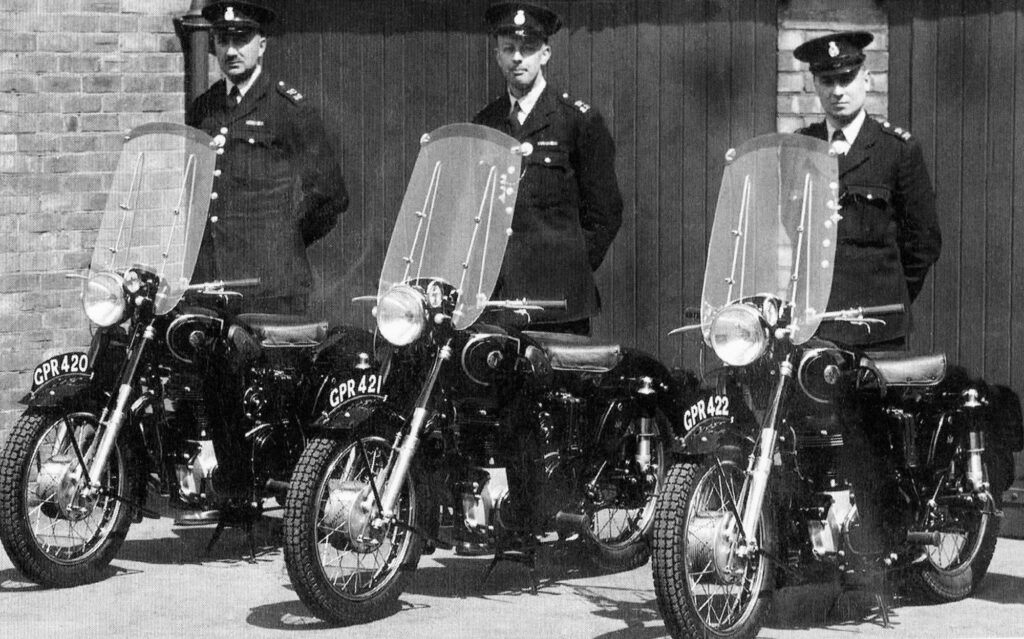
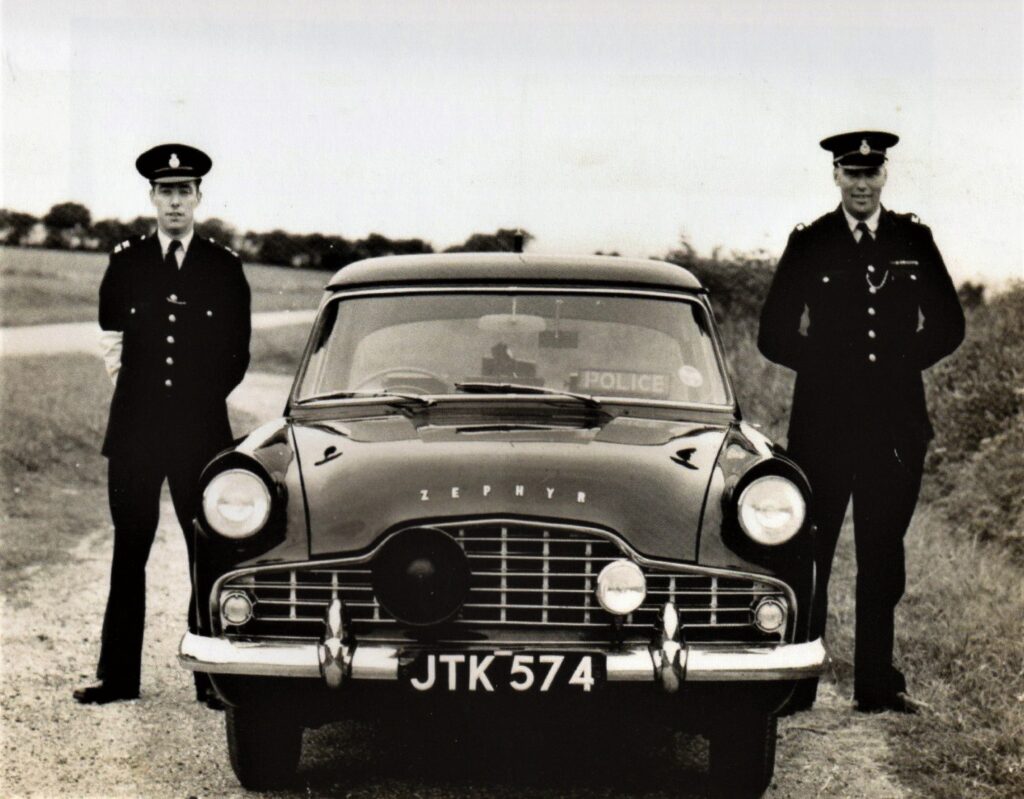
Above is a photograph of Ron BEALE and possibly Jeff KELLAWAY with their patrol car, probably in the Sherborne area. With thanks to Ron’s daughter Sue BEALE.
Below Ray SANSOM in his Ford Zephyr motor patrol car in 1964, which Ray gave me.
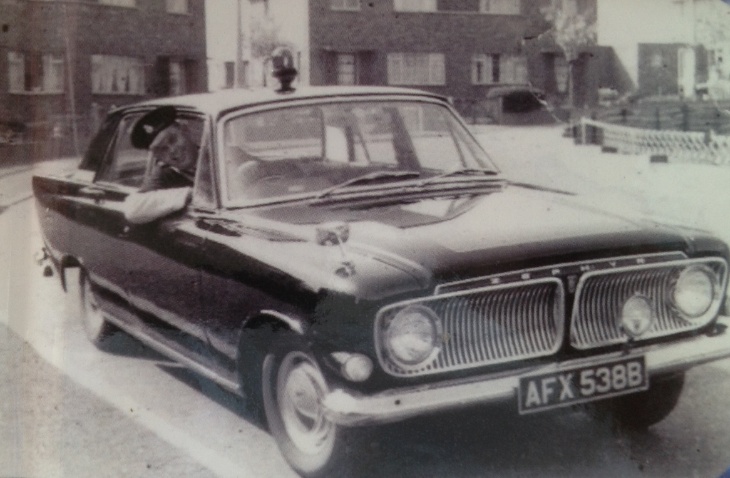
Other great photographs, this one from 1966.
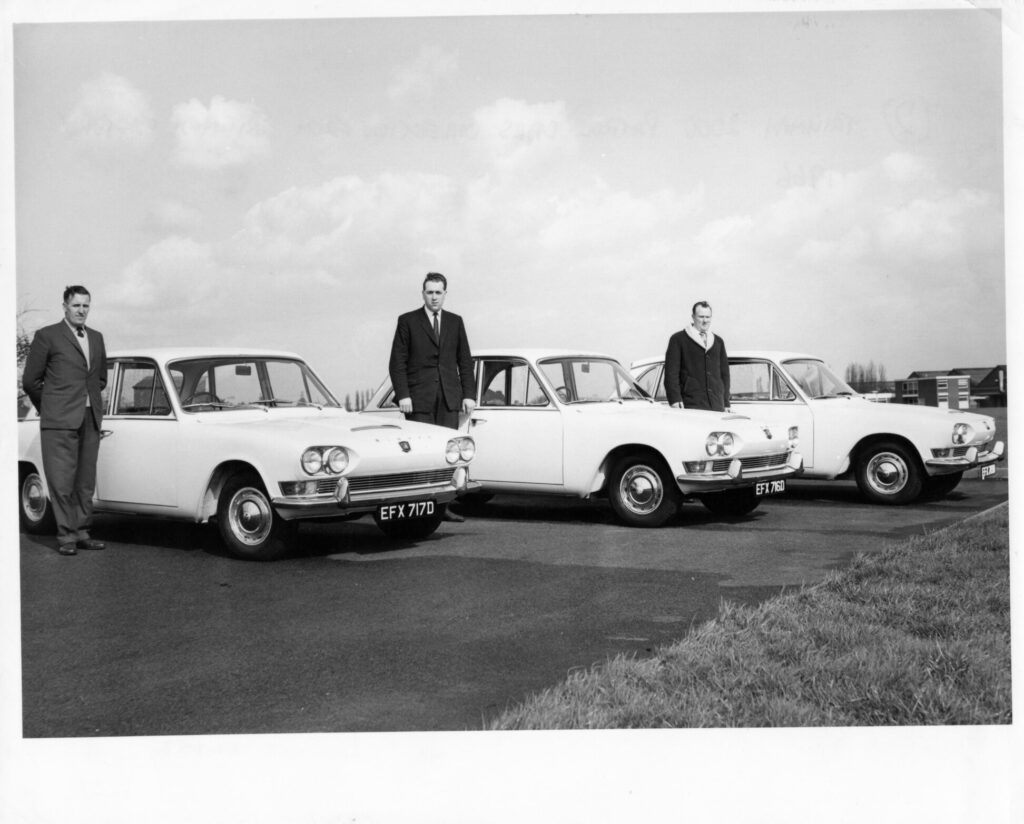

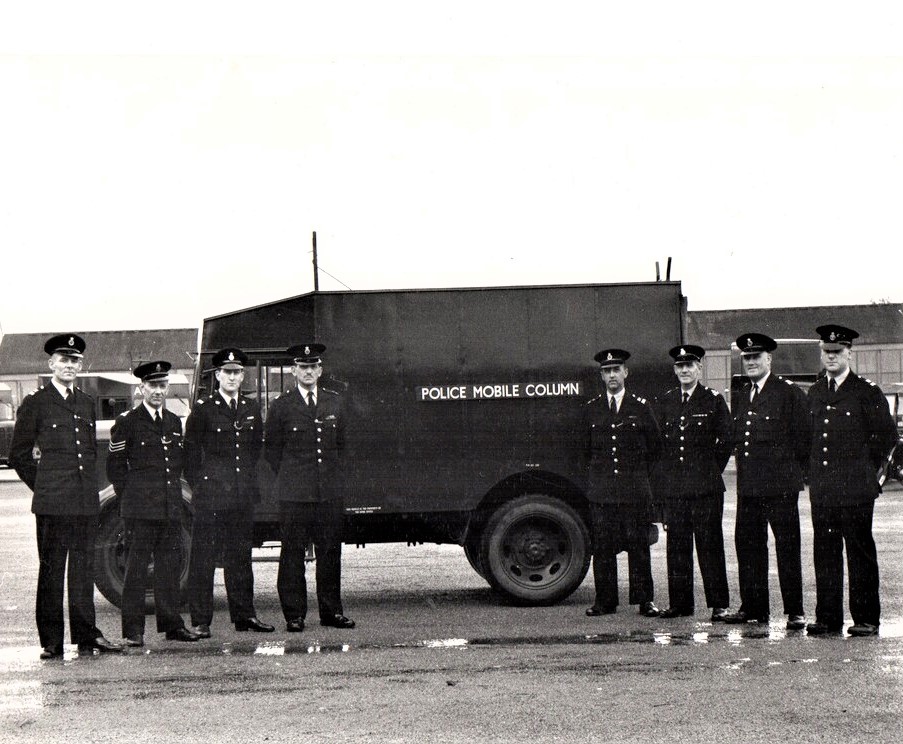
Traffic is a huge subject so hopefully you can give me a few more stories and correct my mistakes.
Cars were really small in those days, can you tell me about any Hillman Imps, that certain officers could not drive, because they just could not get into !
Can you update me on the Traffic officers from the 1950’s and 1960’s ?
Do you have any other photographs I can use and display to update this post?
If you think one of your ancestors was in the Traffic Department then let me know !
Anyway
STAY SAFE AND DRIVE CAREFULLY !
IAN